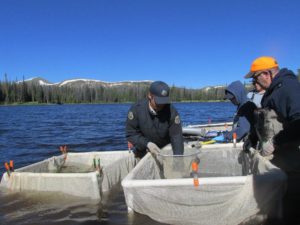Heather holds a nice South Platte River rainbow.
Photo Courtesy of Brandon Miller
Colorado Trout Unlimited’s The Greenbacks have a new president. Founder of The Greenbacks Nick Hoover has recently handed the position of president off to Heather Sees. Heather is a dedicated fly fisher, employee, volunteer and steward of the land. Her passion for protecting and conserving wild, native spaces falls right in line with The Greenback’s original goals and has allowed her to make a few of her own. Her ability to articulate the needs of a community allow her to cast a wide net over a diverse group of peoples; this combined with her dedication to involving disenfranchised youth in the outdoors ensure The Greenbacks will not feel the growing pains that usually come with leadership change. Heather’s no bull all straight talk leadership style combined with her community based approach to relationships make her the perfect fit for the job.
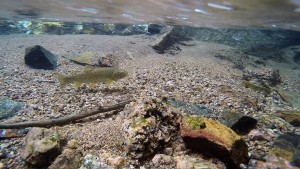
Before Heather was president of The Greenbacks I knew her through time spent on the river. She is a fishing machine to say the least. We spent a day on the frying pan together fishing the toilet bowl and I remember her catching far more fish than me and loosing far less flies. Unlike most fisherman, she is humble, willing to hear all side of an issue and does not fall prey to fallacious arguments. To get to know Heather better as a professional and a leader I was able to ask her some questions about her new found responsibilities.
Why are native trout important to you?
“The Greenbacks are important to me because they represent one of the most diverse trout species in North America. When it was determined that the “pure” strain of Greenbacks was on the verge of extinction I knew that I needed to get involved because I believe it’s important to protect a fish that plays an important role in Colorado’s ecosystem and natural heritage” Heather Sees, President of The Greenbacks.

Why did you take the job as president of The Greenbacks?
“I took this role because I looked at it as a great opportunity to challenge myself personally and challenge those folks who are involved with the Greenbacks. This role also presents an opportunity to build on the strong foundation that we have and expand our role within the fly fishing community and CTU organization.”
What is the keystone character trait in a leader? How do you hope to exemplify that trait in your own leadership?
“For me a key trait is integrity/consistency along with being very self-aware. I am a strong believer that a great leader must lead by example and is consistent in their actions. I consider myself to be one of the most honest (almost to a fault) folks that you will meet. I am also very self-aware – I am tuned into my own limitations and know where I thrive and where I have challenges. Knowing this, I tap into the other Greenbacks members for support so that as a whole we are successful in our mission.”
What are your short term goals for The Greenbacks?
“As of right now the short term goals are to educate folks on the state of the native greenback here in Colorado, engage and recruit new volunteers/members along with partnering with the local Colorado Trout Unlimited chapters on their projects.”
What are your long term goals for The Greenbacks?
“Long term we have plans to champion a big greenbacks recovery project where we can plug in our strong volunteer base. We will also continue to strengthen our youth education program by engaging the local college fly fishing clubs, high school clubs and youth organizations (i.e. BBBS, Girls, Inc, etc).”
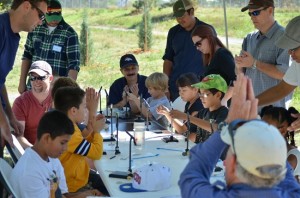
Heather has a lot of work to do. Organizing a group of volunteers to complete what may seem like an unattainable goal, requires dedication and perseverance. Heather embodies both of these traits. These traits do not define her though. She fishes often in her free time and enjoys the social aspect of The Greenbacks. Her passion for the outdoors runs deep. She exudes stewardship and genuinely cares about the health of ecosystems. Thank you Heather for striving to make Colorado a more native place.
If you would like to get involved with The Greenbacks check out their website for awesome fly tying events, volunteer projects, and monthly meetings.






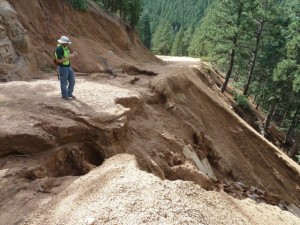 Trout populations can be negatively affected by this excessive sediment, and it can take years for these populations to recover. According to CPW, "The South Platte River in and downstream of the Hayman burn area has only recently begun to return to the quality fishery that it was prior to the fire." The Hayman fire occurred in 2002.
Trout populations can be negatively affected by this excessive sediment, and it can take years for these populations to recover. According to CPW, "The South Platte River in and downstream of the Hayman burn area has only recently begun to return to the quality fishery that it was prior to the fire." The Hayman fire occurred in 2002.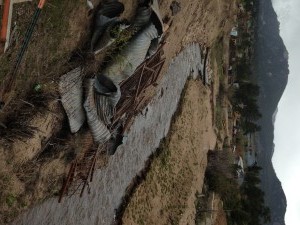
 The mighty river also irrigates more than 1.8 million acres of land- producing about 15 percent of the nation’s crops and about 13 percent of livestock. These totals generate about $1.5 billion a year in agricultural benefits.
The mighty river also irrigates more than 1.8 million acres of land- producing about 15 percent of the nation’s crops and about 13 percent of livestock. These totals generate about $1.5 billion a year in agricultural benefits. Another project in place to keep the Colorado River healthy is the
Another project in place to keep the Colorado River healthy is the  While further on down from the headwaters, Trout Unlimited is teaming up with ranchers and cattlemen to use water
While further on down from the headwaters, Trout Unlimited is teaming up with ranchers and cattlemen to use water 



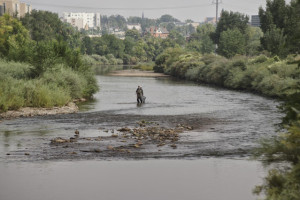 As the Denver Metro area continues to grow, the water needs rise with it and the unreliable flows from the South Platte River aren't enough to supply roughly 80% of the state's population with water throughout the year. Which is why water from the Upper Colorado River headwaters- in this case the Fraser River- are diverted for Front Range usage.
As the Denver Metro area continues to grow, the water needs rise with it and the unreliable flows from the South Platte River aren't enough to supply roughly 80% of the state's population with water throughout the year. Which is why water from the Upper Colorado River headwaters- in this case the Fraser River- are diverted for Front Range usage. Learning by Doing requires regular monitoring of stream temperature, riparian vegetation, and aquatic macro-invertebrates. If an environmental problem is detected, Denver Water will provide some financial support and additional flows to help solve the issue. This includes providing the flushing flows the river needs in the spring to clean sediment build up.
Learning by Doing requires regular monitoring of stream temperature, riparian vegetation, and aquatic macro-invertebrates. If an environmental problem is detected, Denver Water will provide some financial support and additional flows to help solve the issue. This includes providing the flushing flows the river needs in the spring to clean sediment build up.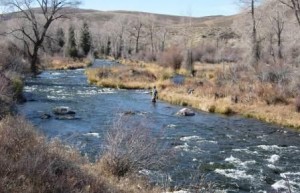 "This project strikes a necessary balance between the water needs of Front Range municipalities and the need to protect healthy flows and fish and wildlife habitat in the Fraser River," said David Nickum, Executive Director of Colorado TU. "The so-called “Learning by Doing” program in the proposal sets up a collaborative process that requires water users to monitor the health of the river in coming years and adjust operations to address unforeseen challenges and opportunities. Moreover, Denver Water has entered into partnerships on the Front Range to ensure that the project alleviates chronic low-flow problems in South Boulder Creek. Both sides of the Divide benefit.”
"This project strikes a necessary balance between the water needs of Front Range municipalities and the need to protect healthy flows and fish and wildlife habitat in the Fraser River," said David Nickum, Executive Director of Colorado TU. "The so-called “Learning by Doing” program in the proposal sets up a collaborative process that requires water users to monitor the health of the river in coming years and adjust operations to address unforeseen challenges and opportunities. Moreover, Denver Water has entered into partnerships on the Front Range to ensure that the project alleviates chronic low-flow problems in South Boulder Creek. Both sides of the Divide benefit.”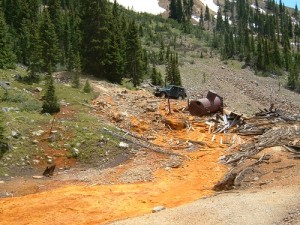 The estimated costs to clean up these sites range from $32-72 billion. Trout Unlimited initiated our Western Abandoned Hard Rock Mine Restoration Program in 2004 to both clean up problem mine sites that impact streams and fisheries, and to draw attention to the challenges associated with these efforts. From our innovative mine tailings revegetation projects addressing toxic mine tailings in Colorado to our successful floodplain restoration projects in Montana, Trout Unlimited has earned national recognition as the leading practitioner of Good Samaritan abandoned mine restoration in the country.
The estimated costs to clean up these sites range from $32-72 billion. Trout Unlimited initiated our Western Abandoned Hard Rock Mine Restoration Program in 2004 to both clean up problem mine sites that impact streams and fisheries, and to draw attention to the challenges associated with these efforts. From our innovative mine tailings revegetation projects addressing toxic mine tailings in Colorado to our successful floodplain restoration projects in Montana, Trout Unlimited has earned national recognition as the leading practitioner of Good Samaritan abandoned mine restoration in the country.
